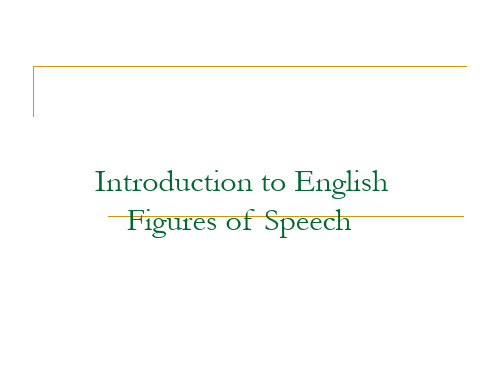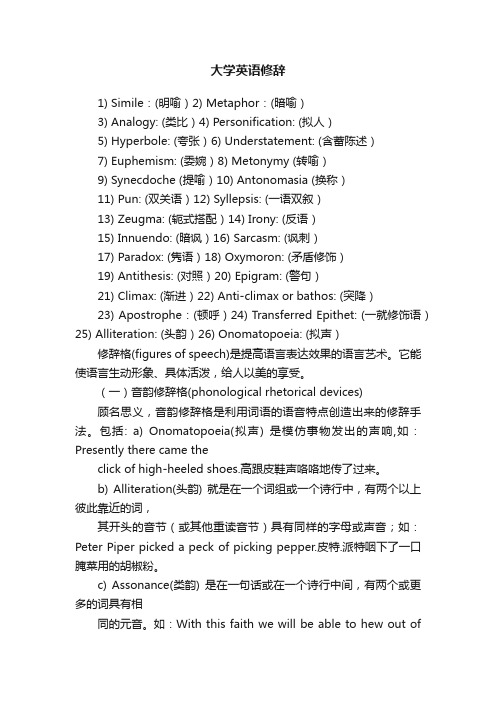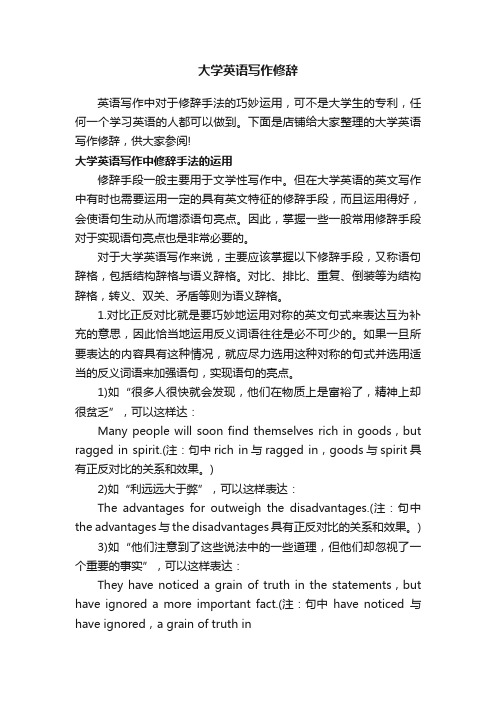高职高专《大学英语》中的常用修辞手法研究
- 格式:pdf
- 大小:189.51 KB
- 文档页数:2


76语言研究英语语言文学中的常用修辞手法研究闻婷南通大学摘要:在英语作品当中,需要借助大量的修辞手法传递思想、强调语意,使用修辞手法时,将提高英语语言的可读性与趣味性作为主要目标,给予夸大音效、激活语言、彰显文体高度重视,这与英语修辞现象有着直接关联。
本文首先分析习英语语言文学中的常用修辞手法的重要性,逐一阐述英语语言文学中的常用修辞手法及英语文学作品中修辞手法的具体应用,以此更好的理解英语。
关键词:英语语言文学;修辞手法;应用研究一、学习英语语言文学中的修辞手法的意义(一)增强欣赏水平阅读水平的高低,与学好修辞手法有着直接关联,英语的语法与表现形式与我们的汉语有着较大差异。
在平日的英语教学过程中,一些教师所选择的教育方式存在弊端,只是将词语进行逐一翻译,然后再进行排列句互译,受这种翻译方法的影响,难以提高英语学习水平。
这样的翻译方式相对生硬,无法将英语的灵动之美完全体现出来,导致英语文章苍白枯燥。
将学好修辞手法作为基础,在阅读的过程中了解作者想要表达的情感,领悟文章当中的内涵,提高阅读欣赏水平。
(二)提升语言素养英语属于一门语言类学科,与我国的汉语存在许多共同之处,在语言当中,必定包含大量的修辞手法,以此丰富文章内容,学习英语语言文学当中的修辞手法,能够更加顺利的提高英语理解水平,增强英语语言的实际运用能力。
学好常用的修辞手法,切实提高语言素养,单纯依靠死记硬背,难以学好英语这门学科,只有提高理解能力,才能够加深对英语的理解,游刃有余的进行阅读与写作。
在进行翻译与写作的过程中,学好修辞手法起到关键作用,理解作者想要表达的情感,提高文学素养。
(三)提高应用能力学好英语这门学科,不应仅仅局限于书本上,这门学科的学习与我们的日常生活有着必然关联。
英语是全世界的通用语言,学好英语这门语言,在实际生活当中与人进行熟练交流,将其作用充分发挥出来,而不仅仅是纸上谈兵。
掌握英语文学当中的修辞手法,加深对英语这门学科的了解,自如应用到生活实践当中。

大学英语修辞1) Simile:(明喻)2) Metaphor:(暗喻)3) Analogy: (类比)4) Personification: (拟人)5) Hyperbole: (夸张)6) Understatement: (含蓄陈述)7) Euphemism: (委婉)8) Metonymy (转喻)9) Synecdoche (提喻)10) Antonomasia (换称)11) Pun: (双关语)12) Syllepsis: (一语双叙)13) Zeugma: (轭式搭配)14) Irony: (反语)15) Innuendo: (暗讽)16) Sarcasm: (讽刺)17) Paradox: (隽语)18) Oxymoron: (矛盾修饰)19) Antithesis: (对照)20) Epigram: (警句)21) Climax: (渐进)22) Anti-climax or bathos: (突降)23) Apostrophe:(顿呼)24) Transferred Epithet: (一就修饰语)25) Alliteration: (头韵)26) Onomatopoeia: (拟声)修辞格(figures of speech)是提高语言表达效果的语言艺术。
它能使语言生动形象、具体活泼,给人以美的享受。
(一)音韵修辞格(phonological rhetorical devices)顾名思义,音韵修辞格是利用词语的语音特点创造出来的修辞手法。
包括: a) Onomatopoeia(拟声) 是模仿事物发出的声响,如:Presently there came theclick of high-heeled shoes.高跟皮鞋声咯咯地传了过来。
b) Alliteration(头韵) 就是在一个词组或一个诗行中,有两个以上彼此靠近的词,其开头的音节(或其他重读音节)具有同样的字母或声音;如:Peter Piper picked a peck of picking pepper.皮特.派特咽下了一口腌菜用的胡椒粉。

大学英语写作修辞英语写作中对于修辞手法的巧妙运用,可不是大学生的专利,任何一个学习英语的人都可以做到。
下面是店铺给大家整理的大学英语写作修辞,供大家参阅!大学英语写作中修辞手法的运用修辞手段一般主要用于文学性写作中。
但在大学英语的英文写作中有时也需要运用一定的具有英文特征的修辞手段,而且运用得好,会使语句生动从而增添语句亮点。
因此,掌握一些一般常用修辞手段对于实现语句亮点也是非常必要的。
对于大学英语写作来说,主要应该掌握以下修辞手段,又称语句辞格,包括结构辞格与语义辞格。
对比、排比、重复、倒装等为结构辞格,转义、双关、矛盾等则为语义辞格。
1.对比正反对比就是要巧妙地运用对称的英文句式来表达互为补充的意思,因此恰当地运用反义词语往往是必不可少的。
如果一旦所要表达的内容具有这种情况,就应尽力选用这种对称的句式并选用适当的反义词语来加强语句,实现语句的亮点。
1)如“很多人很快就会发现,他们在物质上是富裕了,精神上却很贫乏”,可以这样达:Many people will soon find themselves rich in goods,but ragged in spirit.(注:句中rich in与ragged in,goods与spirit具有正反对比的关系和效果。
)2)如“利远远大于弊”,可以这样表达:The advantages for outweigh the disadvantages.(注:句中the advantages与the disadvantages具有正反对比的关系和效果。
)3)如“他们注意到了这些说法中的一些道理,但他们却忽视了一个重要的事实”,可以这样表达:They have noticed a grain of truth in the statements,but have ignored a more important fact.(注:句中have noticed与have ignored,a grain of truth inthe statements与a more important fact具有正反对比的关系和效果。

大学英语教学中常见的修辞格作者:赛汉其其格来源:《赤峰学院学报·哲学社会科学版》 2012年第3期(赤峰学院大学外语部,内蒙古赤峰 024000)摘要:修辞格(tropes)作为一种语言表达的艺术形式,在英语语言中的运用是必不可少的。
所谓修辞是指依据题旨情境恰当地选择语言手段和表达方式,以有效地表情达意。
修辞的目的是使作品更加形象生动,引人入胜。
英语语言中的修辞格多种多样,它可借助语音、语法或词汇几种手段对语言进行修饰,。
本文着重介绍在大学英语教学中最常见的使用词汇修辞手段(lexical rhetorical devices)的几种主要的修辞格。
关键词:大学英语教学;修辞格;词汇修辞格中图分类号:G623.31文献标识码:A文章编号:1673-2596(2012)03-0262-02Simile(明喻)与汉语的明喻基本相同,使以两种相同的事物和现象进行对比,表明本体和喻体之间的相似关系。
常用来表示明喻的喻词有like, as, as though, as if 等。
如:(1)O,my luve is like a red, red roseThat’s newly sprung in June,O,my luve is like a melodyThat’s sweetly played in tune.(Robert Burns)(2)As cold waters toathirsty soul, so is good news from a far country.类似as…as的用法很普遍,有的成了习惯用语。
如:as timid as a mouse (胆小如鼠)as white as snow (白如雪)as black as pitch (乌黑)as busy as a bee (像蜜蜂一样忙碌的人)metaphor(暗喻)又称隐喻,暗喻也是一种比喻,但它的结构不同于明喻,没有as或like之类的喻词,因此被称为是缩减了的比喻(a compressed simile)。

- 55 -校园英语 / 职业教育研究浅谈英语常见的修辞方法重庆化工职业学院/冯兰【摘要】高职英语教学中,学生在阅读和行文中常遇到各种修饰手法,恰当使用修辞方法能使语言更有感染力,达到更好的表达效果。
是一种能加强说服力的手段。
因此加强对修辞法的学习,能助学生丰富他们的表达,理解作者的情感,提升自我品味。
【关键词】高职高专英语文学修饰手法语言是表达思想的工具,修辞则是语言表达的艺术,每种语言都有它自己的修辞。
本文将对高职高专英语学习中常见的几种修饰手法做浅显的分析。
一、明喻(simile)明喻是英文修辞中最常用的辞格,它以此喻彼,将有共性的不同事物来作对比.这种共性存在于人们的心里脑海中,而不是事物的自然属性.它的基础是心理上的联想,联想必然会产生于不同事物的比拟。
明喻中常会用到的结构有:like/likened to/as...as.../A is to be what/as if/as though/similar to 等。
明喻包含三个部分:本体(ontology),喻体(metaphors),比喻词(metaphors)。
如:The sun looks like a ball of fire.(太阳像一个炙热的火球)。
the sun(太阳)——本体; a ball of fire(火球)——喻体; looks like(像)——比喻词。
又如:His new neighbor is as cold as ice.(他的新邻居冷若冰霜)。
二、隐喻(metaphor)隐喻是进行隐藏比较的一种修辞手段。
隐喻也是比喻的一种,用一种事物暗喻另一种事物,所以主体与喻体的关系就显得十分紧密。
如:Success is a bastard as it has many fathers, and failure is an orphan, with no takers 。
再如:He was fairly certain that life was a fashion show.(他相当确定生活就是一场时装秀)。
英语中的修辞手法分析修辞手法是指在表达中使用一些艺术手法,以达到增强语言表达力、引起读者情感共鸣、达到修辞效果的目的。
在英语写作中,修辞手法的运用可以使文章更加生动有趣,让读者对文章产生深入印象。
本文将分析英语中常见的一些修辞手法,并举例说明其运用。
一、比喻(Metaphor)比喻是一种常见的修辞手法,通过将一个事物与另一个事物进行类比,以便让读者更好地理解所描述的对象或情感。
比如,“She is a rosein the garden of love.”(她是爱之花园中的一朵玫瑰),这里将“她”比作“花园中的一朵玫瑰”,以形象地表达出对她美丽和爱的赞美。
二、拟人(Personification)拟人是将无生命的事物或抽象概念赋予人的特质或行为,以便使描述更加形象生动。
例如,“The wind howled in the darkness.”(风在黑暗中咆哮)这里将风与人的行为“咆哮”联系起来,使得描写更加富有感情和形象。
三、反问(Rhetorical Question)反问是一种修辞手法,在陈述问题时使用疑问句的方式,不要求回答,而是用来增强说服力和引起读者注意。
例如,“Can you imagine a world without music?”(你能想象没有音乐的世界吗?)这种反问引起读者对音乐的重要性的思考,并在不同程度上影响读者情感。
四、排比(Parallelism)排比是通过使用类似的结构或语法来强调一系列相关的概念或事件,以便增强表达的力度和节奏感。
例如,“They saw. They conquered. They left a legacy.”(他们见证了,他们征服了,他们留下了遗产)此处使用并列的结构,使得表达更加明确和有力。
五、夸张(Hyperbole)夸张是一种修辞手法,通过过分强调某一情感或观点,以便吸引读者的注意和共鸣。
例如,“I've told you a million times.”(我已经告诉你一百万次了)这里的“一百万次”明显是夸张的说法,但它强调了作者重复告诉的次数,以表达出对对方的焦急与无奈。
大学英语修辞手法总结大学英语修辞手法总结大学英语都有哪些修辞手法呢?下面四小编整理的大学英语修辞手法总结,欢迎阅读!大学英语修辞手法总结1) Simile:(明喻)It is a figure of speech which makes a comparison between two unlike elements having at least one quality or characteristic (特性)in common. To make the comparison, words like as, as...as, as if and like are used to transfer the quality we associate with one to the other. For example, As cold waters to a thirsty soul, so is good news from a far country.2) Metaphor:(暗喻)It is like a simile, also makes a comparison between two unlike elements, but unlike a simile, this comparison is implied rather than stated. For example, the world is a stage.3) Analogy: (类比)It is also a form of comparison, but unlike simile or metaphor which usually uses comparison on one point of resemblance, analogy draws a parallel between two unlike things that have several common qualities or points of resemblance.4) Personification: (拟人)It gives human form of feelings to animals, or life and personal attributes(赋予) to inanimate(无生命的') objects, or to ideas and abstractions(抽象). For example, the wind whistled through the trees.5) Hyperbole: (夸张):It is the deliberate use of overstatement or exaggeration to achieve emphasis. For instance, he almost died laughing.6) Understatement: (含蓄陈述) It is the opposite ofhyperbole, or overstatement. It achieves its effect of emphasizing a fact by deliberately(故意地) understating it, impressing the listener or the reader more by what is merely implied or left unsaid than by bare statement. For instance, It is no laughing matter.7) Euphemism: (委婉) It is the substitution of an agreeable or inoffensive(无冒犯) expression for one that may offend or suggest something unpleasant. For instance, we refer to "die" as” pass away".8) Metonymy (转喻) It is a figure of speech that has to do with the substitution of the mane of one thing for that of another. For instance, the pen (words) is mightier than the sword (forces).9) Synecdoche (提喻) It is involves the substitution of the part for the whole, or the whole for the part. For instance, they say there's bread and work for all. She was dressed in silks.10) Antonomasia (换喻)It has also to do with substitution. It is not often mentioned now, though it is still in frequent use. For example, Solomon for a wise man. Daniel for a wise and fair judge. Judas for a traitor.11) Pun: (双关语) It is a play on words, or rather a play on the form and meaning of words. For instance, a cannon-ball took off his legs, so he laid down his arms. (Here "arms" has two meanings: a person's body; weapons carried by a soldier.)12) Solipsism: (一语双叙) It has two connotations. In the first case, it is a figure by which a word, or a particular form or inflection of a word, refers to two or more words in the same sentence, while properly applying to or agreeing with only on of them in grammar or syntax(句法). For example, He addressed you and me, and desired us to follow him. (Here we are used to refer to you and me.)In the second case, it a word may refer to two or more words in the same sentence. For example, while he was fighting, and losing limb and mind, and dying, others stayed behind to pursue education and career. (Here to losing one's limbs in literal; to lose one's mind is figurative, and means to go mad.)13) Zeugma: (轭式搭配) It is a single word which is made to modify or to govern two or more words in the same sentence, wither properly applying in sense to only one of them, or applying to them in different senses. For example, the sun shall not burn you by day or the moon by night. (Here noon is not strong enough to burn)14) Irony: (反语) It is a figure of speech that achieves emphasis by saying the opposite of what is meant, the intended meaning of the words being the opposite of their usual sense. For instance, we are lucky, what you said makes me feel real good.15) Innuendo: (暗讽) It is a mild form of irony, hinting in a rather roundabout (曲折)way at something disparaging(不一致) or uncomplimentary(不赞美) to the person or subject mentioned. For example, the weatherman said it would be worm. He must take his readings in a bathroom.16) Sarcasm: (讽刺) It Sarcasm is a strong form of irony. It attacks in a taunting and bitter manner, and its aim is to disparage, ridicule and wound the feelings of the subject attacked. For example, laws are like cobwebs, which may catch small flies, but let wasps break through.17) Paradox: (似非而是的隽语) It is a figure of speech consisting of a statement or proposition which on the face of it seems self-contradictory, absurd or contrary toestablished fact or practice, but which onfurther thinking and study may prove to be true, well-founded, and even to contain a succinct point. Forexample more haste, less speed.18) Oxymoron: (矛盾修饰)It is a compressed paradox, formed by the conjoining(结合) of two contrasting, contradictory or incongruous(不协调) terms as in bitter-sweet memories, orderly chaos(混乱) and proud humility(侮辱).19) Antithesis: (对照) It is the deliberate arrangement of contrasting words or ideas in balanced structural forms to achieve emphasis. For example, speech is silver; silence is golden.20) Epigram: (警句) It states a simple truth pithily(有利地) and pungently(强烈地). It is usually terse and arouses interest and surprise by its deep insight into certain aspects of human behavior or feeling. For instance, Few, save the poor, feel for the poor.21) Climax: (渐进) It is derived from the Greek word for "ladder" and implies the progression of thought at a uniform or almost uniform rate of significance or intensity, like the steps of a ladder ascending evenly. For example, I came, I saw, I conquered.22) Anti-climax or bathos: (突降)It is the opposite of Climax. It involves stating one's thoughts in a descending order of significance or intensity, from strong to weak, from weighty to light or frivolous. For instance, But thousands die, without or this or that, die, and endow(赋予) a college, or a cat.23) Apostrophe: (顿呼) In this figure of speech, a thing, place, idea or person (dead or absent) is addressed as if present, listening and understanding what is being said.For instance, England! awake! awake! awake!24) Transferred Epithet: (转类形容词) It is a figure of speech where an epithet (an adjective or descriptive phrase) is transferred from the noun it should rightly modify(修饰) toanother to which it does not really apply or belong. For instance,I spent sleepless nights on my project.25) Alliteration: (头韵) It has to do with the sound rather than the sense of words for effect. It is a device that repeats the same sound at frequent intervals(间隔) and since the sound repeated is usually the initial consonant sound, it is also called "front rhyme". For instance, the fair breeze blew, the white foam flew, the furrow followed free.26) Onomatopoeia: (拟声) It is a device that uses words which imitate the sounds made by an object (animate or inanimate), or which are associated with or suggestive(提示的) of some action or movement。
英语修辞手法分析大全一、明喻(simile)是以两种具有相同特征的事物和现象进行对比,表明本体和喻体之间的相似关系,两者都在对比中出现。
常用比喻词like, as, as if, as though 等,例如:1、This elephant is like a snake as anybody can see.这头象和任何人见到的一样像一条蛇。
2、He looked as if he had just stepped out of my book of fairytales and had passed me like a spirit.他看上去好像刚从我的童话故事书中走出来,像幽灵一样从我身旁走过去。
3、It has long leaves that sway in the wind like slim fingers reaching to touch something.它那长长的叶子在风中摆动,好像伸出纤细的手指去触摸什么东西似的。
二、隐喻(metaphor)这种比喻不通过比喻词进行,而是直接将用事物当作乙事物来描写,甲乙两事物之间的联系和相似之处是暗含的。
1、German guns and German planes rained down bombs, shells and bullets...德国人的枪炮和飞机将炸弹、炮弹和子弹像暴雨一样倾泻下来。
2、The diamond department was the heart and center of the store.钻石部是商店的心脏和核心。
三、提喻(synecdoche)又称举隅法,主要特点是局部代表全体,或以全体喻指部分,或以抽象代具体,或以具体代抽象。
例如:1、The Great Wall was made not only of stones and earth, but of the flesh and blood of millions of men.长城不仅是用石头和土建造的,而且是用几百万人的血和肉建成的。